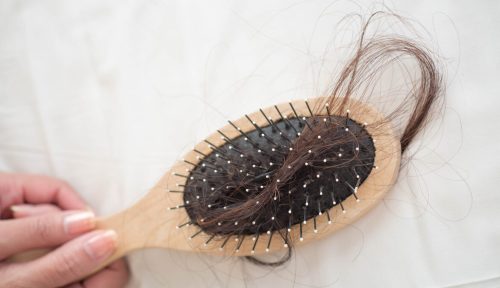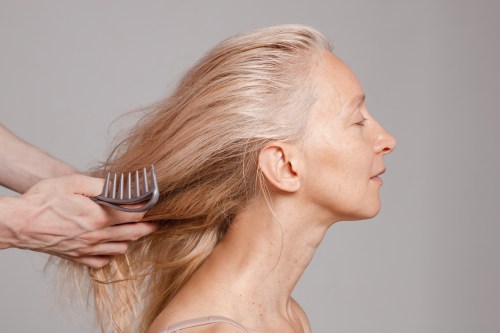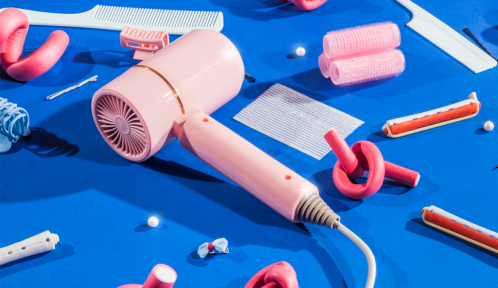Post-COVID Hair Loss Is a Real Thing. Here’s How To Deal With It
While temporary and reversible, post-COVID hair loss can be terrifying. Here's how to navigate it, plus next steps to promote regrowth.

You’re noticing your shower drain is clogged. You’re shedding like crazy all over your sweaters. And, while most people besides your hairdresser can’t tell on sight, your thick hair isn’t quite as luscious as it used to be. You might be wondering if you’re washing it too much, if you need to get to a doctor to run some labs, or if the stress of worrying about it is making it worse.
Experts in This Article
board-certified physician’s assistant at the Northwest Dermatology Institute in Portland, Oregon
board-certified dermatologist at the Northwest Dermatology Institute in Portland, Oregon
If you’ve had COVID in the last few months, though, you might be losing your hair as a post-COVID reaction.
Who does post-COVID hair loss affect?
While one study said that 22 percent of people who were hospitalized with COVID developed post-COVID hair loss, the number of people affected overall is likely much higher than that since it can also affect people who had cases that didn’t require hospitalization. Nisha S. Desai, MD, dermatologist, and Kerianne McKeon, PA-C, physician assistant, from Northwest Dermatology Institute in Portland, Oregon (one of the few hair loss referral centers in the United States), wrote over email that they are seeing post-COVID hair loss frequently.
“Some studies show that it can affect approximately 20 to 67 percent of people who have had COVID-19,” they shared. Potentially, more than half of everyone who has had COVID has lost hair afterward.
And you don’t have to have had severe COVID to have this reaction after recovery. However, the specialists say, “the severity of COVID-19 can be directly correlated with the severity of the hair loss. For example, a patient who was hospitalized for COVID-19 is more likely to have a greater degree of hair loss than someone who has had mild symptoms.”
When is hair loss a sign of something more?
Throughout the course of a day, we typically lose 50 to 100 strands of hair. Losing more than that for one to three months after having COVID indicates post-COVID hair loss. You might lose just over the daily norm, or up to a thousand strands in a day.
“Patients should not worry unless the total duration of the shedding is lasting more than six months, or if the hair loss is occurring in irregularly shaped patches,” say Desai and McKeon. In that case, it’s worth getting checked out by your regular healthcare provider or making an appointment with a dermatologist, since there are other conditions that lead to hair loss, including alopecia, thyroid disorders, or male or female pattern baldness.
Timeline of hair loss: What to expect
At Northwest Dermatology, the researchers and specialists have observed two patterns in post-COVID hair loss. Classic telogen effluvium, or hair loss due to stress, is the most common pattern they see after COVID-19 (as well as other viral infections). The stress of the illness causes some hair follicles to convert from a growing phase to a shedding phase. The specialists say they see patients begin losing hair eight to 12 weeks after the infection—which sometimes makes it hard to connect the dots if you had COVID several months ago.
The less common pattern they’ve observed is called dystrophic anagen effluvium, which is characterized by hair loss that starts sooner than eight weeks after their illness. The specialists think the cause of this version of hair loss is caused by “direct attack of the hair follicles by the SARS-CoV-2 virus.” With this type, some people also have scalp pain.
Fortunately, either way, this reaction is not a lifelong sentence. “Post-COVID hair loss is common, temporary, and reversible (the hair will grow back)! Most cases resolve on their own without any additional treatment,” say Desai and McKeon. It can be scary to throw away bigger-than-usual balls of hair, but the people who have experienced this already have seen full recovery of their previous hair thickness.
The specialists say the shedding can last three to six months, and most people see their hair regain its normal fullness within six to 12 months after the shedding resolves.
Ways to help your hair grow back
If you’re eager to get your locks back, there are several hair loss solutions and products on the market. You can also treat your hair gently, avoiding over styling or heating.
However, our experts say, “There are no treatments that can prevent or alter the ultimate course of the hair loss. Hair will often begin to grow back on its own as early as one month after the loss began,” but it can take a full year to get back to its complete fullness. They say topical or oral minoxidil or platelet rich plasma (PRP) may speed up the regrowth process, but it is often not necessary since “most patients will not require interventions to slow down post-COVID loss.”
When to follow up with your doctor
It’s possible, though uncommon, that your post-COVID hair loss can stick around past the one-year mark. “There are some occasions when telogen effluvium may unmask another hair loss condition such as female or male pattern hair loss,” say Desai and McKeon. More than likely, however, extended hair loss is due to a treatable health problem like an iron or vitamin D deficiency, or abnormalities in your thyroid function.
With long COVID in the news, you might be concerned that hair loss is indicating that you’re a “long hauler,” and that you will be feeling other symptoms like fatigue, brain fog, or muscle pain. Fortunately, hair loss is not a sign that you have long COVID. It’s one, isolated, unpleasant but temporary post-COVID effect that will, in all likelihood, be over soon.
Sign Up for Our Daily Newsletter
Get all the latest in wellness, trends, food, fitness, beauty, and more delivered right to your inbox.
Got it, you've been added to our email list.










